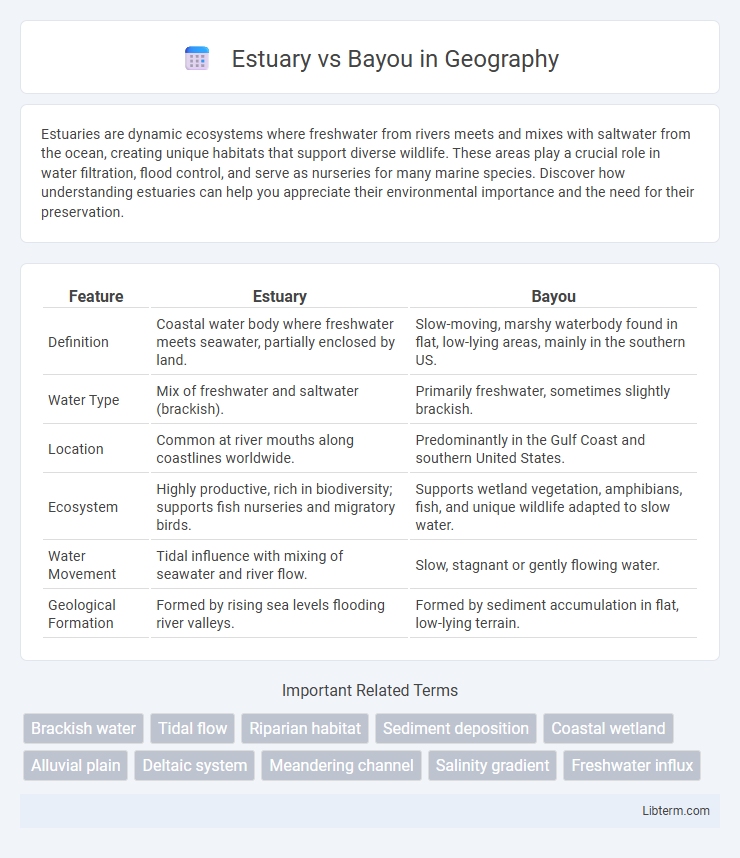Estuaries are dynamic ecosystems where freshwater from rivers meets and mixes with saltwater from the ocean, creating unique habitats that support diverse wildlife. These areas play a crucial role in water filtration, flood control, and serve as nurseries for many marine species. Discover how understanding estuaries can help you appreciate their environmental importance and the need for their preservation.
Table of Comparison
| Feature | Estuary | Bayou |
|---|---|---|
| Definition | Coastal water body where freshwater meets seawater, partially enclosed by land. | Slow-moving, marshy waterbody found in flat, low-lying areas, mainly in the southern US. |
| Water Type | Mix of freshwater and saltwater (brackish). | Primarily freshwater, sometimes slightly brackish. |
| Location | Common at river mouths along coastlines worldwide. | Predominantly in the Gulf Coast and southern United States. |
| Ecosystem | Highly productive, rich in biodiversity; supports fish nurseries and migratory birds. | Supports wetland vegetation, amphibians, fish, and unique wildlife adapted to slow water. |
| Water Movement | Tidal influence with mixing of seawater and river flow. | Slow, stagnant or gently flowing water. |
| Geological Formation | Formed by rising sea levels flooding river valleys. | Formed by sediment accumulation in flat, low-lying terrain. |
Introduction to Estuaries and Bayous
Estuaries are coastal water bodies where freshwater from rivers meets and mixes with saltwater from the ocean, creating a unique brackish environment that supports diverse ecosystems. Bayous are slow-moving, often swampy waterways typically found in low-lying regions like the Gulf Coast, characterized by stagnant or sluggish water flow and rich in wetland vegetation. Both estuaries and bayous serve as critical habitats for wildlife, but differ in their hydrology, salinity levels, and ecological functions.
Defining Estuaries: Key Features
Estuaries are coastal water bodies where freshwater from rivers meets and mixes with saltwater from the ocean, creating unique brackish water environments. Key features of estuaries include tidal influences, nutrient-rich sediments, and diverse habitats supporting high biodiversity and productive ecosystems. Their ecological importance is reflected in roles like nursery grounds for marine species, natural water filtration, and protection against storm surges.
Understanding Bayous: Unique Characteristics
Bayous are slow-moving, marshy waterways typically found in low-lying coastal regions, especially in the southern United States. Unlike estuaries, which are tidal zones where freshwater mixes with seawater, bayous are often freshwater or brackish and support dense vegetation, including cypress trees and aquatic plants. These unique characteristics create rich habitats for diverse wildlife and serve as crucial components of wetland ecosystems.
Geographic Locations of Estuaries and Bayous
Estuaries are coastal water bodies where freshwater from rivers meets and mixes with saltwater from the ocean, commonly found along shorelines worldwide, including major examples like the Chesapeake Bay in the United States and the Thames Estuary in the United Kingdom. Bayous are slow-moving, swampy waterways prevalent primarily in the southern United States, especially in states such as Louisiana and Texas, often forming part of larger delta systems like the Mississippi River Delta. Geographic distinctions highlight that estuaries are typically open coastal zones with tidal influences, while bayous are inland, marshy channels or creeks influenced by freshwater and localized flooding.
Formation Processes: Estuary vs Bayou
Estuaries form where freshwater from rivers meets and mixes with saltwater from the sea, creating a unique brackish environment influenced by tidal fluctuations and sediment deposition. Bayous develop in low-lying, slow-moving water areas, typically in flat regions like the Gulf Coast, where water accumulates in stagnant or gently flowing channels often rich in organic material. The dynamic mixing in estuaries contrasts with the stagnant, swampy conditions characteristic of bayous, shaping distinct ecosystems and sedimentary patterns.
Biodiversity and Wildlife in Estuaries and Bayous
Estuaries support a high level of biodiversity due to the mixing of fresh and saltwater, creating nutrient-rich habitats that sustain diverse species like shellfish, fish, and migratory birds. Bayous, often slow-moving or stagnant water bodies in low-lying areas, harbor unique freshwater and brackish species adapted to swampy environments, including amphibians, reptiles, and various invertebrates. The contrasting salinity and water flow regimes in estuaries and bayous shape distinct ecosystems that are crucial for breeding, feeding, and sheltering diverse wildlife populations.
Ecological Importance and Benefits
Estuaries serve as critical nurseries for numerous marine species, supporting biodiversity by providing nutrient-rich waters and protected breeding grounds. Bayous offer unique wetland habitats that capture pollutants, filter water, and mitigate flooding, enhancing water quality and ecosystem resilience. Both estuaries and bayous contribute significantly to carbon sequestration, climate regulation, and sustaining fisheries vital to local economies.
Human Activities and Impact
Human activities in estuaries often include commercial fishing, shipping, and urban development, which can increase pollution and disrupt delicate saltwater-freshwater ecosystems. Bayous, commonly found in southern U.S. regions like Louisiana, face impacts from agriculture runoff, oil drilling, and water diversion, leading to habitat degradation and loss of biodiversity. Both estuaries and bayous require careful management to mitigate human-induced threats and preserve their vital ecological functions.
Popular Examples Around the World
The San Francisco Estuary in California exemplifies a dynamic coastal estuary where freshwater from the Sacramento and San Joaquin rivers meets the Pacific Ocean, supporting diverse ecosystems and urban settlements. In contrast, the Louisiana Bayou network, particularly around the Mississippi River Delta, showcases slow-moving, swampy waterways rich in biodiversity and culturally significant communities. Both environments illustrate the distinct ecological and geographical features that define estuaries and bayous globally.
Estuary vs Bayou: Key Differences and Similarities
Estuaries are coastal water bodies where freshwater from rivers meets and mixes with saltwater from the ocean, creating a unique brackish environment rich in biodiversity and nutrient exchange. Bayous are slow-moving or stagnant bodies of water, typically found in flat, low-lying areas such as the Gulf Coast, characterized by freshwater ecosystems with dense vegetation and distinctive wildlife like alligators and wading birds. Both estuaries and bayous serve crucial ecological roles as habitats and nurseries for various aquatic species, but estuaries are defined by their saltwater-freshwater interface, whereas bayous are primarily freshwater and more associated with swampy or marshy landscapes.
Estuary Infographic

 libterm.com
libterm.com